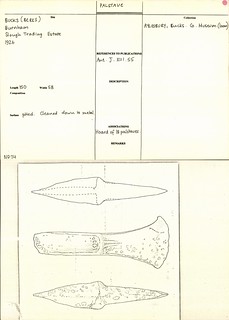BM Bronze Age Index Draw A9 transcription tutorial
This application is very simple, but does require you to use your own judgment in reading hand-written documents. When you participate, the platform will load a scanned index card from the British Museum's Bronze Age catalog (stored on the MicroPasts Flickr stream). Once the image has been loaded, you will be asked to transcribe the contents of each card. Most scanned images combine the written details from the one side of the index card and the line drawing of the object from the reverse side. An example of the front side of a card is shown below.

Each index card contains similar information and we are asking you to enter this information into a set of pre-defined fields. In addition to the help provided by this tutorial, you will also find further hints inside the data entry boxes about where on the card the relevant information might be found (e.g. in the example card above, the necessary entry for the "Object Type" filed would be "Palstave" and the data entry box will hint that this information can be found "Top of card").
During the transcription, you can always return to this tutorial via the "Help" button. Here are some further issues to watch out for:
- The "top right corner" field is not present on all cards, but if it exists, it is normally a typological code
including a Latin numeral, following by an ordinary (Arabic) number, and finally a capital letter.
This is often but not always written in pencil. The example below would be rendered "II1A":

- When entering information in the fields, please respect the case of words as seen on the card.
- If there is a word or a portion of a word that you cannot read, please use the "[...]" notation. For example, using the example index card shown before, if you could not read the reference top left to "Sea-shore near Cooden Bay", you might render it as "Sea-shore near [...] Bay", although we suggest you do fill in the whole word in cases where you are fairly confident but not certain.
- If you see text that is stacked on more than one line or separated by a gap, but that otherwise should go into just one of our pre-specified boxes, then separate it by "[;]". For example, on the index card we showed you before, "Mr Vidler" and "Pevensey" are both entries that should be entered in the the Collection box, so you could simply enter "Mr Vidler[;]Pevensey".
- Measurements should be entered in millimetres or grammes, as the hints suggest, and only the number should be entered in the box (e.g. a length of 174mm should be entered as 174). If the units are not in mm or grammes, please convert them to whole number grammes and mm, and place the converted values in the correct box. In such cases, please also make a note of the original in the Transcriber's Comments (e.g. a length written as "4.2 in" should be note verbatim in the Transcriber's Comments, but recorded as 107 in the Length box).
- If there is additional information on the card that you do not feel fits in one of our pre-specified boxes, or if you have any further worries about how to transcribe the card, then please put these concerns in our "Transcriber's Comments" box at the bottom of the transcription page.
Sometimes you might notice that there is some variability in the style of the index cards and occasionally you might get a card that looks quite different, such as the one below. In such cases, please try your best to fill in the requisite fields and note in the Transcriber's Comments field that you found this difficult for that particular card. As we continue drawer-by-drawer through the catalog, we will look to modify the input fields in response to your suggestions.

To find out how the project is progressing, suggest changes to this application or propose new research ideas based what you have transcribed, please have a look at our community forum.




